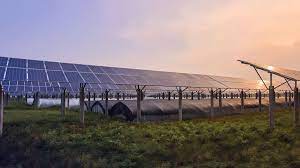Agrivoltaics: a good practice for renewables
Written by Aggeliki Marinou, environmental specialist at Wattcrop
The main threat facing our planet is the impact of climate change. There is a need to redefine the way that we find, use and conserve energy and natural resources, as they are key to slowing down climate change and can lead our planet to more sustainable development. A massive shift to clean energy systems and a greater use of renewable energy sources is strongly recommended.
In recent years there has been a rapid growth and demand for photovoltaic projects. Photovoltaic technology due to its smart structure, cost reduction, long lifetime and improved efficiency plays an important role in the transition to a low-carbon society. However, land-based PV farms are competing with the food production sector in terms of land coverage. Innovative solutions have already been implemented to implement photovoltaic systems while reducing land use. Photovoltaic systems on buildings that make use of existing building surfaces, floating photovoltaic systems use the existing water surface and agricultural systems use agricultural land are some examples.
What exactly are agrivoltaics?
The combination of solar photovoltaic energy production with agriculture on the same land, although it is an idea that first appeared in 1981, it took a long time before the word Agrivoltaics was coined and its advantages were fully understood.
Agrivoltaics is about combining agriculture and renewable energy production, for example, solar panels and crops on the same land area. Whereas in the past either food or solar energy production would have taken place on agricultural land, now with the use of agrovoltaics both can be combined successfully resulting in greater efficiency in both activities.
The benefits of Agrivoltaics:

The benefits of Agrivoltaics are significant as it enhances climate resilience and allows sustainable food and energy production on a single piece of land. Crops that are usually grown and harvested by hand or with small machinery are used under the panels, such as shade-loving crops, fruit trees or shrubs of small stature. Initially, the quality of the crops is improved as the Agrivoltaics systems act as a shield against excessive solar radiation, heat, drought, or heavy rainfall. Crops are thereby protected from intense heat or rain allowing them to grow unaffected by seasonal changes. In addition, the shade created by the panels helps to keep the soil moist for a long period of time, thus providing the plants with an optimal water supply.

The positive impact of combining agricultural land with photovoltaic parks on the environment is obvious, as this condition contributes to the preservation and improvement of the ecosystem. Solar farms have high yields as the vegetation underneath the photovoltaic panels reduces the temperature of the panels, preventing a reduction in their efficiency. Also, using Agrivoltaics increase the productivity of the land. Farming the land while producing energy means farmers and energy producers can reap benefits and profits for all involved, while maintaining the rural character of the land.
The acceleration of the energy transition is obvious. The use of Agrivoltaics have grown rapidly in recent years and more and more countries are investing in this practice. Germany, Italy, the United States and Japan are among the main countries that have adopted this model and intend to continue investing, as the coexistence of renewable energy and agriculture is sustainable and highly beneficial for both sectors.

